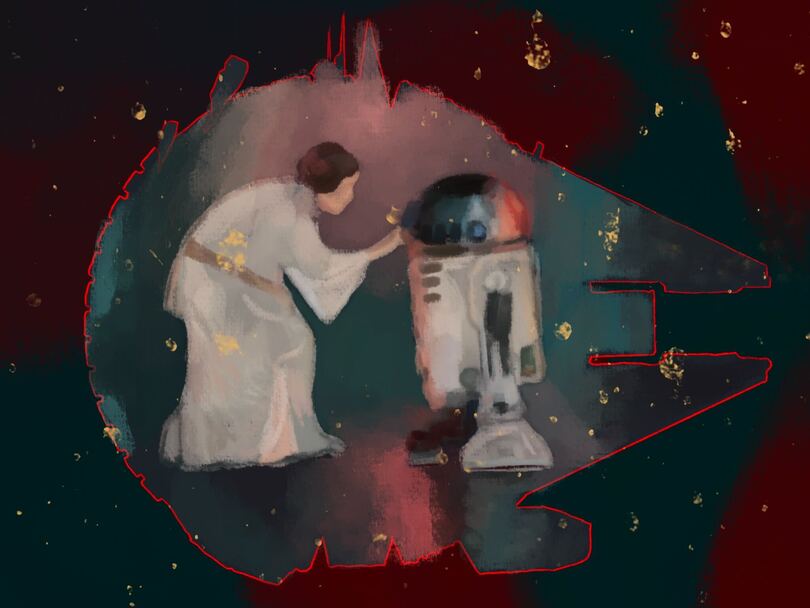The sound, storytelling of ‘Star Wars’ revolutionized the film industry

Yiwei He | Illustration Editor
After releasing “Star Wars: Episode IV — A New Hope” 45 years ago, George Lucas went on to make one of the most iconic and influential movie franchises in the world.
Get the latest Syracuse news delivered right to your inbox.
Subscribe to our newsletter here.
In “Star Wars: Episode IV — A New Hope,” Obi-Wan Kenobi says, “You’ve taken your first step into a larger world,” signaling to Luke Skywalker that he is about to become part of the Jedi order. These words, however, could’ve also served as a message to the Star Wars audience that they were entering a new world of pop culture.
In the 45 years since the first film’s release, the “Star Wars” brand has garnered 10 movies, nine television shows and millions of fans all around the world who come together to celebrate the franchise they love. But the true legacy of “Star Wars” exists outside of the movies, television and merchandise. The release of “Star Wars: Episode IV — A New Hope” on May 4, 1977 changed the movie industry forever, and revolutionized the role a piece of popular culture can play in Hollywood.
In the 1970s, dramatic, actor-driven movies such as “The Godfather” and “Taxi Driver” dominated Hollywood. The idea of a blockbuster film, which “Star Wars” eventually perfected, didn’t really come to fruition until the 1975 picture “Jaws.”
Not only were these films financially successful, but they also emphasized bringing thrill and excitement to the audience for the first time. The new atmosphere in the theater had a momentous impact on the way studios approached filmmaking, which is clear in some of the biggest franchises of the 1980s, such as “Indiana Jones” and “Back to the Future.”
In fact, the Marvel Cinematic Universe would not have been nearly as successful without the franchise blueprint director George Lucas laid out in “Star Wars.” In addition to creating an outstanding individual film, Lucas was also a master at world-building, and easily told supplemental stories about the surrounding galaxy.
Lucas also had a major impact on the shift to a new era of special effects and science fiction film-making.
Before he created the “Star Wars” universe, Lucas wanted to produce a story about Flash Gordon, a famous science fiction character. When he was younger, Lucas was obsessed with the 1936 serial about a space cowboy hero who is pulled into a universe that he does not fully understand. To Lucas, Flash Gordon was the perfect adventure story, and he was amazed at the fantastical sets and action sequences in the show.
Thus, it is not surprising that Lucas had a monumental effect on science fiction storytelling with the “Star Wars” franchise.
When “Star Wars” was first released in 1977, fans were amazed at the combination of both practical and visual effects that the film crew implemented to create the galaxy “far, far away.” Lucas and his special effects team used several matte paintings, miniature sets and puppets to bring the world to life.
During the filming of “Star Wars,” Lucas founded Industrial Light and Magic (ILM), a group that constructed robots and spaceship models from scratch, helping to make the “space opera” feel as realistic as possible.
Take the final space battle for example. Although this scene is essentially a dog fight in outer space, all of the sounds and visual effects help the audience feel immersed in the action, and share the intensity of the moment with the characters.
A major element of the incredible “Star Wars” production was the story’s sound. Legendary sound designer Ben Burtt helped create many of the iconic sounds that give life to the galaxy. Between droids, spaceships and all kinds of aliens, Burtt made the Star Wars universe feel real, even though many of the characters in it are not human.
Any conversation about sound in film would not be complete without mentioning arguably the greatest film composer ever, John Williams. The scores that Williams wrote add to the emotion of each scene, and tell stories through music. While ILM made “Star Wars’” iconic visuals, Burtt and Williams make the film stand out through audio as well.
Forty-five years later, the original “Star Wars” is a joy to rewatch and reflect on. The universe that Lucas created is still a landmark in the film industry, and will continue to be for years to come. With more movies and television shows on the horizon, clearly the full story of the “Star Wars” universe is yet to be told.





